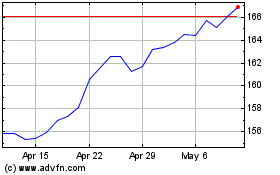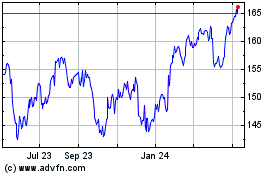Maker of Tide, struggling with scant growth, revises its
'perfect dose.' It now advises using two or three detergent pods
per load.
By Paul Ziobro and Sharon Terlep
When Procter & Gamble Co. launched Tide Pods, the company
touted the dissolvable laundry detergent packets as "the ultimate
perfect dose."
Four years later, the consumer-products giant has a different
message: Some loads might require two -- even three -- of the
now-popular packets. While competitors advise tossing in two
packets for the largest loads, P&G is alone in recommending
triple dosing.
"We find that people need more clarity in judging their load
size. They think it's a large load, but it's actually an
extra-large load," P&G spokeswoman Tracey Long said.
P&G's changing recommendations for a clean load of laundry
come at a time when the company is struggling with scant growth and
few new hit products. Its last hit was Tide Pods in 2012. Now every
major maker of detergent has their own version of the concentrated
laundry packets.
"It's clearly a way to boost sales," said John Replogle, chief
executive of cleaning-products rival Seventh Generation Inc.,
referring to P&G's new recommendations. Seventh Generation
plans to launch its own laundry packets this summer. It will
recommend one for standard or high-efficiency machines and two for
"larger or heavily soiled loads."
P&G's Ms. Long says the company decided to increase the
recommended dose based on customer feedback and its research that
showed people are cramming more laundry into their machines. The
capacity of the biggest washing machines is 30% larger than when
Tide Pods were launched, according to General Electric Co.'s
appliance division.
Other brands, such as Sun Products Corp.'s All Mighty Pacs and
Church & Dwight Co.'s Arm & Hammer Power Paks, advise in
their instructions using one capsule for regular loads, and using
two for large or especially dirty loads.
"For our detergent, two is enough for large loads," a Sun
spokeswoman said.
Single unit-dose detergents now make up nearly 15% of the $7
billion-a-year U.S. laundry-detergent market, according to market
researcher Nielsen NV. Despite these single-packets' higher cost
per wash, their introduction didn't boost the overall market as it
reduced consumers' tendency to overuse liquids and powders.
U.S. laundry-industry sales have fallen in two of the past three
years and eked out 1.6% revenue growth in 2015, according to
Nielsen. Compared with the pre-pod era, overall industry sales are
down nearly 5%.
In recent months, P&G has changed its packaging and
advertising for its Tide Pods. It now recommends three packets for
extra-large laundry loads, two for a large load and one for a small
or medium load. A Tide TV commercial now shows a consumer preparing
a wash with two packets in hand.
Katie Marrero, 48 years old of Brooklyn, switched to Tide Pods a
month ago after tiring of lugging liquid detergent bottles to the
laundromat. She generally uses one packet, and will toss in two for
big loads.
"I didn't read the instructions, I just thought that would
work," said Ms. Marrero, who cares for newborn babies. "One or two
is enough. There are plenty of suds and my clothes get clean."
Appliance manufacturers say there is no evidence to suggest
three packets are needed to get clothes clean or that using too few
packs is a source of problems for consumers. Rather, they say,
high-efficiency washers that use less water require detergent with
a different chemical composition, and have resulted in
less-than-ideal results for some.
"Clean is such a subjective metric," said Jennifer Schoenegge, a
product manager for GE's appliance unit. "We get complaints about
high-efficiency machines not cleaning in the way customers
expect."
Consumer-products companies have a history of encouraging wider
use of their products. In the 1960s, Alka-Seltzer sales jumped
after the manufacturer changed its recommendation to two tablets
and began using the slogan, "plop, plop, fizz, fizz." More
recently, shampoo makers began advising lather, rinse, repeat.
When Tide Pods were first released in 2012, Consumer Reports
determined one packet worked as well as a dose of liquid detergent.
The group doesn't recommend the product for safety reasons, a
spokesperson said.
The packets are pricier than liquid detergents even without
doubling or tripling up. Tide Pods cost 25 cents a load, compared
with 19 cents a load for liquid Tide, according to prices listed
recently by Target Corp. A three-Podload uses 75 cents of
detergent.
Jonna Rubin, a mother of three from Framingham, Mass., switched
to Tide Pods from the brand's powdered detergent shortly after the
packets came out. But even using two Pods wasn't enough to get
paint, food and other stains out of her children's clothes, she
says.
"I was blowing through them at such a rapid pace," Ms. Rubin
said.
She has now reverted back to primarily using powdered Tide
detergent. "I still have this last batch of remaining Pods that I
throw in when I'm desperate," she said.
Write to Paul Ziobro at Paul.Ziobro@wsj.com and Sharon Terlep at
sharon.terlep@wsj.com
(END) Dow Jones Newswires
June 09, 2016 02:48 ET (06:48 GMT)
Copyright (c) 2016 Dow Jones & Company, Inc.
Procter and Gamble (NYSE:PG)
Historical Stock Chart
From Mar 2024 to Apr 2024

Procter and Gamble (NYSE:PG)
Historical Stock Chart
From Apr 2023 to Apr 2024
